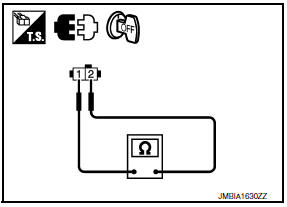Nissan Maxima Service and Repair Manual: P0327, P0328, P0332, P0333 KS
Description
The knock sensor is attached to the cylinder block. It senses engine knocking using a piezoelectric element. A knocking vibration from the cylinder block is sensed as vibrational pressure. This pressure is converted into a voltage signal and sent to the ECM.
DTC Logic
DTC DETECTION LOGIC

DTC CONFIRMATION PROCEDURE
1.PRECONDITIONING
If DTC Confirmation Procedure has been previously conducted, always perform the following before conducting the next test.
- Turn ignition switch OFF and wait at least 10 seconds.
- Turn ignition switch ON.
- Turn ignition switch OFF and wait at least 10 seconds.
TESTING CONDITION: Before performing the following procedure, confirm that battery voltage is more than 10 V at idle.
2.PERFORM DTC CONFIRMATION PROCEDURE
- Start engine and run it for at least 5 seconds at idle speed.
- Check 1st trip DTC.
Diagnosis Procedure
1.CHECK GROUND CONNECTION
- Turn ignition switch OFF.
- Check ground connection E9.
2.CHECK KNOCK SENSOR GROUND CIRCUIT FOR OPEN AND SHORT
- Disconnect knock sensor harness connector and ECM harness connector.
- Check the continuity between knock sensor harness connector and ECM harness connector
- Also check harness for short to ground and short to power.

3.DETECT MALFUNCTIONING PART
Check the following.
- Harness connectors F69, F201
- Harness for open or short between knock sensor and ECM
4.CHECK KNOCK SENSOR INPUT SIGNAL CIRCUIT FOR OPEN AND SHORT
- Check the continuity between knock sensor harness connector and ECM harness connector.
- Also check harness for short to ground and short to power

5.DETECT MALFUNCTIONING PART
Check the following.
- Harness connectors F69, F201
- Harness for open or short between knock sensor and ECM
6.CHECK KNOCK SENSOR
7.CHECK INTERMITTENT INCIDENT
Component Inspection
1.CHECK KNOCK SENSOR

- Turn ignition switch OFF.
- Disconnect knock sensor harness connector.
- Check resistance between knock sensor terminal as per the following. NOTE: It is necessary to use an ohmmeter which can measure more than 10 MΩ.

CAUTION: Never use any knock sensors that have been dropped or physically damaged. Use only new ones.
 P0300, P0301, P0302, P0303, P0304, P0305, P0306 misfire
P0300, P0301, P0302, P0303, P0304, P0305, P0306 misfire
DTC Logic
DTC DETECTION LOGIC
When a misfire occurs, engine speed will fluctuate. If the engine speed
fluctuates enough to cause the crankshaft
position (CKP) sensor (POS) signal to vary, ECM ca ...
 P0335 CKP sensor (POS)
P0335 CKP sensor (POS)
Description
The crankshaft position sensor (POS) is located on the oil pan facing
the gear teeth (cogs) of the signal plate. It detects the fluctuation of
the engine revolution.
The sensor ...
Other materials:
Steering switch
Removal and Installation
REMOVAL
Remove the driver airbag module. Refer to SR-12, "Removal and
Installation".
Remove the steering wheel audio control switch screws (A).
Release the steering wheel audio control switch harness clips
(B).
Remove the steering wheel audio control switc ...
Thermostat and thermostat housing
Removal and Installation
Gasket
Thermostat assembly (water inlet)
WARNING:
Do not remove the radiator cap when the engine is hot. Serious burns could occur
from high pressure
engine coolant escaping from the radiator. Wrap a thick cloth around the
radiator cap. Slowly turn it a
...
Cleaning interior
Occasionally remove loose dust from the interior
trim, plastic parts and seats using a vacuum
cleaner or soft bristled brush. Wipe the vinyl and
leather (if so equipped) surfaces with a clean,
soft cloth dampened in mild soap solution, then
wipe clean with a dry, soft cloth.
Regular care and ...
Nissan Maxima Owners Manual
- Illustrated table of contents
- Safety-Seats, seat belts and supplemental restraint system
- Instruments and controls
- Pre-driving checks and adjustments
- Monitor, climate, audio, phone and voice recognition systems
- Starting and driving
- In case of emergency
- Appearance and care
- Do-it-yourself
- Maintenance and schedules
- Technical and consumer information
Nissan Maxima Service and Repair Manual
0.0071
